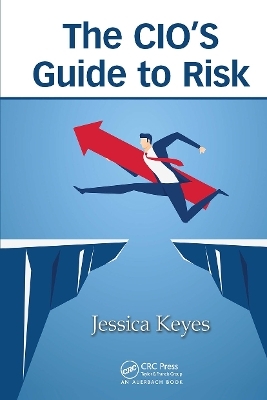
The CIO’s Guide to Risk
Seiten
2023
Auerbach (Verlag)
978-1-032-47647-6 (ISBN)
Auerbach (Verlag)
978-1-032-47647-6 (ISBN)
In an age of globalization, widely distributed systems and rapidly advancing technological change, IT professionals and their managers must understand that risk is inherent in all technological projects. The CIO’s Guide to Risk addresses the many faces of risk, whether it be in procurement, development, innovation or even social media.
In an age of globalization, widely distributed systems, and rapidly advancing technological change, IT professionals and their managers must understand that risk is ever present. The key to project success is to identify risk and subsequently deal with it.
The CIO’s Guide to Risk addresses the many faces of risk, whether it be in systems development, adoption of bleeding edge tech, the push for innovation, and even the march toward all things social media. Risk management planning, risk identification, qualitative and quantitative risk analysis, contingency planning, and risk monitoring and control are all addressed on a macro as well as micro level.
The book begins with a big-picture view of analyzing technology trends to evaluate risk. It shows how to conceptualize trends, analyze their effect on infrastructure, develop metrics to measure success, and assess risk in adapting new technology. The book takes an in-depth look at project-related risks. It explains the fundamentals of project management and how project management relates to systems development and technology implementation. Techniques for analyzing project risk include brainstorming, the Delphi technique, assumption analysis, and decision analysis. Metrics to track and control project risks include the Balance Scorecard, project monitoring and reporting, and business and technology metrics. The book also takes an in-depth look at the role of knowledge management and innovation management in identifying, assessing, and managing risk.
The book concludes with an executive’s guide to the legal and privacy issues related to risk management, as well overviews of risks associated with social media and mobile environments. With its checklists, templates, and worksheets, the book is an indispensable reference on risk and information technology.
In an age of globalization, widely distributed systems, and rapidly advancing technological change, IT professionals and their managers must understand that risk is ever present. The key to project success is to identify risk and subsequently deal with it.
The CIO’s Guide to Risk addresses the many faces of risk, whether it be in systems development, adoption of bleeding edge tech, the push for innovation, and even the march toward all things social media. Risk management planning, risk identification, qualitative and quantitative risk analysis, contingency planning, and risk monitoring and control are all addressed on a macro as well as micro level.
The book begins with a big-picture view of analyzing technology trends to evaluate risk. It shows how to conceptualize trends, analyze their effect on infrastructure, develop metrics to measure success, and assess risk in adapting new technology. The book takes an in-depth look at project-related risks. It explains the fundamentals of project management and how project management relates to systems development and technology implementation. Techniques for analyzing project risk include brainstorming, the Delphi technique, assumption analysis, and decision analysis. Metrics to track and control project risks include the Balance Scorecard, project monitoring and reporting, and business and technology metrics. The book also takes an in-depth look at the role of knowledge management and innovation management in identifying, assessing, and managing risk.
The book concludes with an executive’s guide to the legal and privacy issues related to risk management, as well overviews of risks associated with social media and mobile environments. With its checklists, templates, and worksheets, the book is an indispensable reference on risk and information technology.
Jessica Keyes
1. Analyzing Technology Trends to Evaluate Risk. 2. Information Technology Project Risk. 3. Risk Analysis Techniques. 4. Auditing Knowledge Management to Reduce Risk. 5. Innovation Management to Reduce Risk. 6. Performance Measurement and Management for Reduced Risk. 7. Information Technology Project Tracking and Control. 8. Fundamentals of Information Technology Project Management. 9. Project Critical Success Factors. 10. Legal, Privacy, and Security Risk. 11. Assessment and Mitigation of Risks in a Bring Your Own Device (BYOD) Environment. 12 Social Media Risk.
| Erscheinungsdatum | 11.01.2023 |
|---|---|
| Zusatzinfo | 40 Illustrations, black and white |
| Verlagsort | London |
| Sprache | englisch |
| Maße | 156 x 234 mm |
| Gewicht | 720 g |
| Themenwelt | Wirtschaft ► Betriebswirtschaft / Management ► Allgemeines / Lexika |
| Wirtschaft ► Betriebswirtschaft / Management ► Unternehmensführung / Management | |
| ISBN-10 | 1-032-47647-8 / 1032476478 |
| ISBN-13 | 978-1-032-47647-6 / 9781032476476 |
| Zustand | Neuware |
| Haben Sie eine Frage zum Produkt? |
Mehr entdecken
aus dem Bereich
aus dem Bereich
Buch | Hardcover (2023)
Vahlen (Verlag)
CHF 48,85
Buch | Softcover (2023)
Vahlen (Verlag)
CHF 34,85
umfassende Einführung aus managementorientierter Sicht
Buch | Hardcover (2023)
Springer Gabler (Verlag)
CHF 83,95


